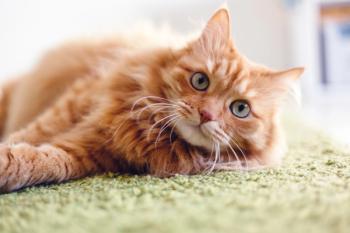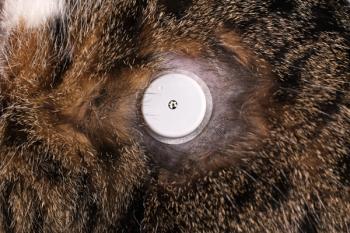
Managing the chronic diabetic dog and cat (Proceedings)
Diabetes mellitus can be a very frustrating disease to deal with. The typical diabetic animal referred to a specialist in internal medicine is invariably difficult to control, insulin resistant, prone to ketoacidosis and/or hypoglycemia, and usually has concurrent diseases that complicate therapy.
Diabetes mellitus can be a very frustrating disease to deal with. The typical diabetic animal referred to a specialist in internal medicine is invariably difficult to control, insulin resistant, prone to ketoacidosis and/or hypoglycemia, and usually has concurrent diseases that complicate therapy. Much of the veterinary literature regarding the management of diabetes concentrates on anticipating and dealing with the difficult to control patient, and emphasizes the problems that can be encountered with a less than ideal approach to therapy. However, although there certainly is an ideal approach to stabilizing and managing diabetes, this approach is often relatively expensive, and can be inconvenient for the average practitioner who does not have the level of support provided by a teaching hospital.
Fortunately, a good number of the diabetic patients seen by general practitioners seem to do well for many years despite extremely minimalistic management approaches, approaches that are dictated by the real world of economic compromise, difficult owners, recalcitrant patients and (sometimes) veterinary ignorance. Many diabetics can be managed with simple therapy.
Meticulous Approach
Although obviously every patient is different, most non-ketoacidotic diabetics are approached in approximately the same fashion. For the purposes of treatment, ketoacidosis is defined as ketonuria and lethargy, anorexia and/or vomiting. Animals with ketones in their urine that are bright, eating well and not vomiting are treated in the same way as non-ketoacidotic patients.
1. Initial Diagnostic Work-up
Search for concurrent illnesses via history, physical examination, hematology, serum biochemistry, urinalysis and urine culture, and consider, based on the results of these results, other tests such as chest and/or abdominal radiography.
2. Commence Dietary Management and Insulin (or Oral Hypoglycemic) Therapy
With canine diabetics, deal with any complicating problems identified during the initial work-up, and then send home on once daily subcutaneous lente (or intermediate-acting) insulin (typically, human recombinant insulin brands such as Humulin® or Novolin® L or N have been used but, since availability of some these products has been steadily drying up, the veterinary pork insulin brand Vetsulin® was, until recent availability issues of its own, the best starting insulin for dogs) at a low dose (0.5 U/kg) each morning for one week. At the same time, commence and consistently adhere to a strict dietary protocol, with one third of the dog's food given prior to insulin, and the other two thirds given eight hours later. Feed a canned high fiber diet to dogs in normal to fat body condition, and a high quality canned dog food to thin dogs. Calculate, based on ideal body weight, the amount of high fiber diet needed for weight reduction in obese dogs.
With feline diabetics, also deal with any problems identified during the initial work-up, and then send home either on insulin or an oral hypoglycemic agent such as glipizide. Cats that are underweight, unwell, or recovering from an episode of ketoacidosis are probably best started on insulin straight away, while dietary therapy and glipizide alone may be appropriate for more stable, heavier cats. Cats have typically received either subcutaneous ultralente insulin such as the human recombinant insulin products Humulin or Novolin U® (but, again, in the US, availability is becoming limited) or, until recent problems with availability,, the veterinary beef PZI insulin provided through Idexx (standard lente insulin is too short-acting for once daily use in cats) at a low starting dose of 0.5 U/kg each morning, or subcutaneous lente insulin (Humulin® or Novolin® L or N, or Vetsulin®) or the new human product insulin glargine (Lantus®, see More Recent Therapies section below) at 0.5 U/kg twice daily, or oral glipizide at a starting dose of 2.5 mg orally twice daily. At the same time, commence a strict dietary protocol, especially in those cats receiving insulin, with one third of the daily food requirements given prior to the morning insulin injection if the cat is eating canned food, and the remaining two thirds given eight hours later. Since cats tend to graze dry food, in those cats that are eating predominantly dry food the food is usually given ad lib. Standardly, it has been recommended to feed a high fiber diet to cats in normal to fat body condition, and a high quality canned or dry food to thin cats. However, more recently, a high protein diet has also been shown to be beneficial in the management of feline diabetes. Several commercial high protein dry and canned cat diets designed specifically for diabetic patients are now available. In obese cats, calculate, based on ideal body weight, the exact amount of food needed for weight reduction.
3. Perform a Glucose Curve
One week later, in those animals on insulin, have owners give insulin as usual in the morning, and admit the fasted patient for 24 hours (once daily insulin) or 12 hours (twice daily insulin). Measure blood glucose levels using dipsticks or a glucometer every two hours over the day and the night (if needed). Continue until glucose levels rise to above analyzable range. The main purpose of this curve is to determine the insulin duration of effect, not the ideal dose. With insulin glargine, since it usually takes 2-4 weeks for full effects to be seen, adjusting therapy based on glucose curves in the first few weeks can lead to dangerous overdoses: early glucose curves in cats on glargine should be performed merely to ensure that hypoglycemia is not occurring.
4. Adjust Dietary and Insulin (or Oral Hypoglycemic) Therapy
In canine patients, switch to either twice daily lente or (in rare circumstances) once daily ultralente (long-acting) insulin if the duration of insulin action is found to be much less than twenty-four hours. Otherwise continue with once daily insulin injections as before. Adjust the timing of the evening meal so it is just before peak insulin effect. In cats, switch to twice daily lente, twice daily glargine, or even twice daily ultralente insulin if the duration of effect of the ultralente insulin is significantly less than twenty-four hours.
Send the owners home with urine dipsticks, ask them monitor thirst and appetite and to measure urine glucose and ketones daily (at a different time each day), and to record results in a diary. At intervals of no more than once or at most twice weekly, gradually adjust insulin doses upwards or downwards based on clinical signs and urine glucose results (aim for negative or trace urine glucoses). Blood fructosamine (half-life two to three weeks) or glycated hemoglobin (half-life two to three months) levels can be measured to better evaluate adequacy of long-term diabetic control.
In those cats on glipizide, the oral dose can be increased to 5 mg twice daily or even higher if the starting dose is not effective at controlling signs. Oral hypoglycemic agents may need to be given for two to three months before maximum efficacy is achieved. Insulin should be commenced in those cats in which glipizide is not effective.
5. Repeat Glucose Curves
Perform a repeat in-hospital glucose curve at regular intervals during initial stabilization (every one to two weeks), every three to six months thereafter, or whenever unusual or difficult to explain clinical signs or results are obtained. Fructosamine or glycated hemoglobin levels may also be assessed at regular intervals.
6. Investigate Suspected Insulin Resistance
Insulin resistance should be suspected if, after meticulous adherence to the above protocol, the patient requires more than 2 units/kg/day of insulin. Some of the more common causes of insulin resistance that should be considered include:
Obesity
Post-estrus progesterone phase in the intact female
Occult bacterial infection (especially urinary tract infection)
Hyperadrenocorticism (Cushing's disease)
Other medications (especially systemic or even topical glucocorticoids)
Hidden illnesses (especially neoplasia in older animals)
Antibodies to insulin of non-dog or non-cat origin (rare)
Diagnostic testing that may be considered in animals with insulin resistance include chest/abdominal radiography, abdominal ultrasonography, vaginal cytology, urine culture, and ACTH stimulation and/or low-dose dexamethasone suppression testing.
7. Consider More Recent Therapies
Recently, the use of a number of oral hypoglycemic agents other than glipizide have been described in small animal diabetic patients (especially cats), and utilization of these in the individual animal may stabilize control or significantly reduce insulin doses.
Consider:
Glimiperide (like glipizide, a sulfonylurea): 2 mg/cat once daily
Acarbose (an agent that decreases intestinal glucose absorption) 12.5 to 25 mg/cat/meal
Troglitazone (a drug that alters glucose metabolism) 200 mg/cat once daily
Chromium picolinate (an insulinomimetic transition metal) 200 µg/cat once daily
Vanadium (another transition metal): 'Vanadyl Fuel' Half capsule once daily, on food
Recently, a new synthetic analogue, insulin glargine (Lantus® insulin) has been developed for use in people, for once daily use. This product has been evaluated in cats. While once daily administration of insulin glargine at 0.5U/kg cause a significant blood glucose lowering effect in cats, a longer effect was attained by giving glargine at 0.25U/kg to 0.5 U/kg twice daily. This product may therefore, on first analysis, appear not be a significant improvement on current standard insulin forms. However, in some diabetic cats supported with insulin glargine, eventually (after weeks or sometimes many months) no ongoing insulin therapy was required. These 'cures' are most likely early on in the course of diabetes suggesting that, in order to maximize the chances of this response, insulin glargine may now be the starting insulin of choice in cats.
Simplifying Management
I always offer owners the above meticulous approach to the management of diabetes mellitus. In my opinion, a meticulous work-up offers the best chance of obtaining successful control of the diabetic patient. Any compromise has the potential for creating avoidable problems. However, circumstances often dictate that we must minimize or simplify our diagnostic and therapeutic strategies. How can we keep management simple? Some useful guidelines:
1. Don't forget the little things.
Before embarking on extensive trouble-shooting, check that the owners are handling the insulin correctly, that is, the insulin is refrigerated, gently mixed (not shaken), and administered correctly. When in doubt, make an appointment for the owners to show you how they do things. Insulin can be inactivated by inappropriate handling even prior to purchase, so always consider trying a new bottle of insulin.
2. Diet is important.
Appropriate dietary therapy can sometimes dramatically stabilize control and decrease insulin requirements. Except in underweight animals, giving a high fiber diet seems to be the most appropriate means of feeding diabetic patients, and minimizes problems with post-prandial hyperglycemia. Foods that cause a marked post-prandial glucose surge, such as semi-moist pet foods and table scraps, should stringently avoided. Canned food is usually preferred, at least in dogs, because the time of feeding can be controlled, although the occasional less greedy dog that grazes a dry food all day also does well. Obesity, a major cause of insulin resistance, should always be specifically corrected.
3. When in doubt, always err on the side of undertreatment.
Most well diabetics have probably been diabetic for months before diagnosis, and a few more weeks of less than perfect control while therapy is fine-tuned is unlikely to make much difference. Many of the problems seen with poor control in diabetic people, such as retinopathies, cardiovascular disease, renal disease and infections, uncommonly present major problems dogs and cats, although dogs can get cataracts and cats occasionally get peripheral neuropathies. Over-treatment of diabetic patients, in contrast, will cause hypoglycemia, which can be immediately life-threatening. Therefore, when it is difficult to do glucose curves, and some doubt regarding insulin dose exists, start with a low dose, and build up slowly (that is, 'Start Low, and Go Slow'. Even a small amount of insulin seems to be enough to prevent the development of ketoacidosis in the well diabetic. Sometimes, owners will be concerned if they are unsure if their pet got its full morning dose of insulin. Reassure them that one day without insulin is unlikely to cause problems. Don't risk giving a double dose.
4. Are glucose curves necessary?
One glucose curve for each form of insulin used is highly desirable, because otherwise the duration of insulin effect will remain unknown. After all, whatever method of monitoring therapy is used, there is no way that adequate control of diabetes can be achieved with once daily lente insulin if duration of effect is only sixteen hours. However, once the type and dosing interval of insulin to be used has been established, clinical signs and urine glucose may be cautiously used to gradually adjust insulin dose to effect. I prefer to have owners keep a diary and call me weekly to discuss adjustments rather than have them adjust doses based on a single dipstick result. My practical therapeutic bottom line is that, if the owners think the animal is doing fine, it probably is, and no single result (dipstick or curve) is going to change my mind. Measurement of either fructosamine or glycated hemoglobin levels may arguably be better tests for the adequacy of long-term diabetic control than urine glucoses or blood glucose curves.
Glucose curves may not be the best means of fine-tuning dose anyway. Physiological changes associated with hospitalization, such as stress and varying activity levels, can often create spurious results (especially in cats and excitable dogs). When reliable curves cannot be obtained, consider switching to twice daily insulin (see below).
5. Is once daily insulin the best alternative?
Traditionally, particularly in dogs, once daily insulin is considered to be the ideal method of treatment, and twice daily insulin is reserved for problem cases. However, if we were giving a drug that lasted less than one day after administration, we would almost certainly give the drug at least twice daily to ensure a constant therapeutic effect. Physiologically, twice daily insulin probably more closely mimics the constant supply of insulin provided by health pancreatic islet cells. In patients that are difficult to control or monitor, consider switching to twice daily insulin. Even if insulin effect does last twenty-four hours, switching to twice daily insulin is safe as long as dosing is conservative (start with half of the single daily dose at each injection). Switching to twice daily insulin has often simplified the control in of my problem patients and, since the Somogyi effect is very unlikely to occur, enables clinical signs and urine glucose to be used as the sole means of monitoring therapy with relative safety.
Once daily insulin requires two regular time commitments from owners, one in the morning and the other for the afternoon meal at peak insulin effect. Since, with twice daily insulin (two equal doses approximately twelve hours apart), feeding at each injection is recommended, owners still only have two regular time commitments, although they do have to give more injections and use more syringes.
6. Consider the easily treatable causes of insulin resistance first.
Before embarking on an extensive investigation of the causes of insulin resistance, try:
Double-checking that the owners aren't giving steroids (even topically)
Neutering the entire female
Giving a course of antibiotics (this works surprisingly frequently)
Switching the origin of the insulin used (from beef to pork, for example)
Switching insulin types is an especially important strategy in cats, who tend to react unpredictably to insulin. Of the ultralente (long-acting) insulins, in some cats the standard human recombinant ultralente (such as Humulin U®, for example) seems to sit under the skin without measurable systemic effects, whereas in the same cats, the other commonly available form of ultralente insulin, PZI, can be effective. PZI has in the past, however, sometimes been difficult to obtain. These days, glargine insulin fills much the same role as PZI used to in cats. In other cats, whereas ultralente insulins are ineffective, twice daily lente insulins work well. Determining which insulin to use in which cat can be a matter or trial and error. Anecdotal evidence and recent published reports suggest that switching to twice daily insulin glargine may be the best way to manage poorly controlled diabetic cats and that, in fact, glargine may be the insulin of first choice in diabetic cats.
7. Consistency in all things.
Owners have a vital role in the control of their diabetic pets. Stress the importance of adhering to a consistent schedule with regards to insulin dosage, feeding and exercise.
8. Recruit the owners
Keen owners may be recruited to monitor, and keep a regular log book of, urine glucose or (better still) blood glucose levels. With the advent of home glucose monitoring devices that only need a drop of blood, owners can often use a lancet of fine needle to collect sufficient blood to regularly monitor glucose from a paw pad or ear tip. Owners should be advised not to use home readings to make decisions regarding changes in insulin therapy themselves. However, with veterinary advice, home glucose monitoring can be used to provide information that can be very useful for fine-tuning insulin doses.
Newsletter
From exam room tips to practice management insights, get trusted veterinary news delivered straight to your inbox—subscribe to dvm360.




